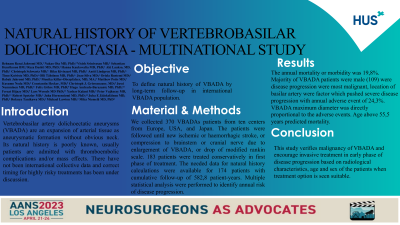Natural History of Vertebrobasilar Dolichoectasia - multinational study
Natural History of Vertebrobasilar Dolichoectasia - Multinational Study
Friday, April 21, 2023


Behnam Rezai Jahromi, MD
MD
Helsinki University Hospital, Department of Neurosurgery
Helsinki, Finland
ePoster Presenter(s)
Introduction: Vertebrobasilar artery dolichoectatic aneurysms (VBADA) are an expansion of arterial tissue as aneurysmatic formation without obvious neck. Its natural history is poorly known, usually patients are admitted with thromboembolic complications and/or mass effects. There have not been international collective data and correct timing for highly risky treatments has been under discussion. To define natural history of VBADA by long-term follow-up in international VBADA population.
Methods: We collected 476 VBADAs patients from ten centers from Europe, USA, and Japan. We excluded patients with follow-up less than 1 month or more than 10 years after diagnosis. The patients were followed until new ischemic or hemorrhagic stroke, or compression to brainstem or cranial nerve due to enlargement of VBADA, or drop of modified rankin scale The needed data for natural history calculations were available for 205 patients with cumulative follow-up of 458 patient-years. Multiple statistical analysis were performed to identify annual risk of disease progression.
Results: The annual mortality or morbidity was 18,9%, the dolichoectasia in vertebral artery was slightly more benign in disease progression than basilar artery (BA). Majority of VBADA were treated early due to severe disease progression. BA size and classification according to VBADA radiological characteristics had impact on natural history. The sex of the patients had no impact to natural history.
Conclusion : VBADA is more malignant than previously reported and invasive treatment is indicated in early phase of disease progression based on radiological characteristics of the patients.
Methods: We collected 476 VBADAs patients from ten centers from Europe, USA, and Japan. We excluded patients with follow-up less than 1 month or more than 10 years after diagnosis. The patients were followed until new ischemic or hemorrhagic stroke, or compression to brainstem or cranial nerve due to enlargement of VBADA, or drop of modified rankin scale The needed data for natural history calculations were available for 205 patients with cumulative follow-up of 458 patient-years. Multiple statistical analysis were performed to identify annual risk of disease progression.
Results: The annual mortality or morbidity was 18,9%, the dolichoectasia in vertebral artery was slightly more benign in disease progression than basilar artery (BA). Majority of VBADA were treated early due to severe disease progression. BA size and classification according to VBADA radiological characteristics had impact on natural history. The sex of the patients had no impact to natural history.
Conclusion : VBADA is more malignant than previously reported and invasive treatment is indicated in early phase of disease progression based on radiological characteristics of the patients.
